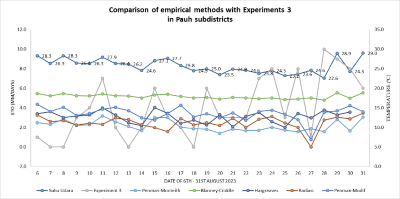The Effect of Elevation Differences on the Estimation of Plant Evapotranspiration in the Kuranji Watershed
DOI:
https://doi.org/10.24036/cived.v12i1.707Keywords:
Evapotranspiration, Elevation, Thermo-Pro, Field Experiments, Empirical ModelsAbstract
This study compares evapotranspiration (ETo) values obtained from direct field observations with estimates from empirical models at different elevation. The empirical models used are Modified Penman, Penman-Monteith, Blaney-Criddle, Hargreaves, and Radiation. This research was conducted in the Batang Kuranji Watershed, specifically in Pauh Subdistrict (174 m above sea level) and Nanggalo Subdistrict (18 m above sea level), from August 6th to August 31st, 2023. Daily temperature, humidity, wind speed, and solar radiation data, collected using Thermo-Pro devices and from relevant agencies, were used as input for the empirical models. Three field experiments were carried out in the form of: evaporation plots, evapotranspiration plots without infiltration influence, and evapotranspiration plots with infiltration influence. Furthermore, the observed ETo values in the field were 90.67 mm/month in Nanggalo and 90.00 mm/month in Pauh. The empirical models produced estimates comparable to field observations. Analysis of the coefficient of determination (R²) revealed that the Modified Penman empirical model was the most suitable with field experiments and showed a very strong relationship (R² = 0.96). The results of this study can be used as a basis for managing rice irrigation water and developing better ETo prediction models, especially in the Batang Kuranji Watershed. The authors identify areas needing further research to enable the model's use for calculating evaporation across an entire growing season.
Downloads
References
B. Triatmodjo, “Hidrologi Terapan,” in Hidrologi Terapan, 2019, pp. 24–27.
L. Zhang et al., “Assessment of spatiotemporal variability of reference evapotranspiration and controlling climate factors over decades in China using geospatial techniques,” Agric Water Manag, vol. 213, pp. 499–511, Mar. 2019, doi: 10.1016/j.agwat.2018.09.037.
R. Fibriana, Y. S. Ginting, E. Ferdiansyah, and S. Mubarak, “Agrotekma Jurnal Agroteknologi dan Ilmu Pertanian Analisis Besar atau Laju Evapotranspirasi pada Daerah Terbuka Large Analysis or Evapotranspiration Rate in the Open Area,” 2018. [Online]. Available: http://ojs.uma.ac.id/index.php/agrotekma
U. K. Priya and R. Senthil, “A review of the impact of the green landscape interventions on the urban microclimate of tropical areas,” Nov. 01, 2021, Elsevier Ltd. doi: 10.1016/j.buildenv.2021.108190.
R. López-Urrea, J. M. Sánchez, F. de la Cruz, J. González-Piqueras, and J. L. Chávez, “Evapotranspiration and crop coefficients from lysimeter measurements for sprinkler-irrigated canola,” Agric Water Manag, vol. 239, Sep. 2020, doi: 10.1016/j.agwat.2020.106260.
H. Saidah, H. Sulistyono, and Muh. B. Budianto, “Kalibrasi Persamaan Thornthwaite Dan Evaporasi Panci Untuk Memprediksi Evapotranspirasi Potensial Pada Daerah Dengan Data Cuaca Terbatas,” JURNAL SAINS TEKNOLOGI & LINGKUNGAN, vol. 6, no. 1, pp. 72–84, Jun. 2020, doi: 10.29303/jstl.v6i1.155.
W. Liu et al., “Effect of elevation on variation in reference evapotranspiration under climate change in northwest china,” Sustainability (Switzerland), vol. 13, no. 18, Sep. 2021, doi: 10.3390/su131810151.
A. Berti, G. Tardivo, A. Chiaudani, F. Rech, and M. Borin, “Assessing reference evapotranspiration by the Hargreaves method in north-eastern Italy,” Agric Water Manag, vol. 140, pp. 20–25, 2014, doi: 10.1016/j.agwat.2014.03.015.
Adlan, B. I. Setiawan, C. Arif, and S. K. Saptomo, “Evaluasi Metode Pendugaan Laju Evapotranspirasi Standar (ETo) Menggunakan Bahasa Pemograman Visual Basic Microsoft Excel di Kabupaten Nagan Raya Aceh,” Jurnal Teknik Sipil dan Lingkungan, vol. 6, no. 1, pp. 35–48, Apr. 2021, doi: 10.29244/jsil.6.1.35-48.
D. Gode, Y. Febe Kurnianto, C. Kusumastuti, and F. Jones Syaranamual, “PERBANDINGAN NILAI EVAPOTRANSPIRASI MENGGUNAKAN METODE THORNTHWAITE DAN BLANEY-CRIDLE DI KABUPATEN MANGGARAI BARAT, KABUPATEN SIKKA, DAN KABUPATEN FLORES TIMUR.”
E. Suhartanto, L. M. Limantara, H. Arum, and R. Tamaya, “PERBANDINGAN METODE EVAPORASI POTENSIAL DI BADAN METEOROLOGI KLIMATOLOGI DAN GEOFISIKA SAWAHAN KABUPATEN NGANJUK, JAWA TIMUR.”
Ahmad Fausan, B. I. Setiawan, C. Arif, and S. K. Saptomo, “Analisa Model Evaporasi dan Evapotranspirasi Menggunakan Pemodelan Matematika pada Visual Basic di Kabupaten Maros,” Jurnal Teknik Sipil dan Lingkungan, vol. 5, no. 3, pp. 179–196, Apr. 2021, doi: 10.29244/jsil.5.3.179-196.
H. D. Abeysiriwardana, N. Muttil, and U. Rathnayake, “A Comparative Study of Potential Evapotranspiration Estimation by Three Methods with FAO Penman–Monteith Method across Sri Lanka,” Hydrology, vol. 9, no. 11, Nov. 2022, doi: 10.3390/hydrology9110206.
A. C. Cunha, L. R. A. G. Filho, A. A. Tanaka, B. C. Goes, and F. F. Putti, “INFLUENCE OF THE ESTIMATED GLOBAL SOLAR RADIATION ON THE REFERENCE EVAPOTRANSPIRATION OBTAINED THROUGH THE PENMAN-MONTEITH FAO 56 METHOD,” Agric Water Manag, vol. 243, Jan. 2021, doi: 10.1016/j.agwat.2020.106491.
A. Sakka et al., “Kajian Ketersediaan Air pada Daerah Irigasi Palakka Kabupaten Bone Provinsi Sulawesi Selatan.”
A. N. Triana, R. H. Purnomo, and F. Khalid, “Study of Water Requirements and Coefficient of Rice Crops (Oryza sativa L) in the Lebak Swamp : Kajian Kebutuhan Air dan Koefisien Tanaman Padi (Oryza sativa L) di Lahan Rawa Lebak,” Jurnal Keteknikan Pertanian, vol. 9, no. 1, pp. 9–16, May 2021, doi: 10.19028/jtep.09.1.9-16.
“document (2)”.
A. Aulia, I. K. Wardani, and A. N. Ichniarsyah, “Penghitungan Evapotranspirasi Aktual (ETc) Tanaman Melon pada Fase Vegetatif di Greenhouse,” Jurnal Keteknikan Pertanian Tropis dan Biosistem, vol. 10, no. 3, pp. 170–180, Dec. 2022, doi: 10.21776/ub.jkptb.2022.010.03.01.
E. Dzisofi Amelia, S. Wahyuni, and D. Harisuseno, “Evaluasi Kesesuaian Data Satelit sebagai Alternatif Ketersediaan Data Evaporasi di Waduk Wonorejo,” Jurnal Teknik Pengairan, vol. 12, no. 2, pp. 127–138, Dec. 2021, doi: 10.21776/ub.pengairan.2021.012.02.05.
“According to the operating system of your smartphone, scan the following QR code to download and install.” [Online]. Available: https://itronicsmall.com/eu-declaration-of-conformity/
A. C. Cunha, L. R. A. G. Filho, A. A. Tanaka, B. C. Goes, and F. F. Putti, “INFLUENCE OF THE ESTIMATED GLOBAL SOLAR RADIATION ON THE REFERENCE EVAPOTRANSPIRATION OBTAINED THROUGH THE PENMAN-MONTEITH FAO 56 METHOD,” Agric Water Manag, vol. 243, Jan. 2021, doi: 10.1016/j.agwat.2020.106491.
“Prepared in cooperation with the Bureau of Reclamation Evapotranspiration from Wetland and Open-Water Sites at Upper Klamath Lake Scientific Investigations Report 2013-5014,” 2008.

Downloads
Published
How to Cite
Issue
Section
License
Copyright (c) 2025 Anastasia Catur Lestari, Darwizal Daoed, Nurhamidah, Junaidi

This work is licensed under a Creative Commons Attribution 4.0 International License.







2.jpg)
